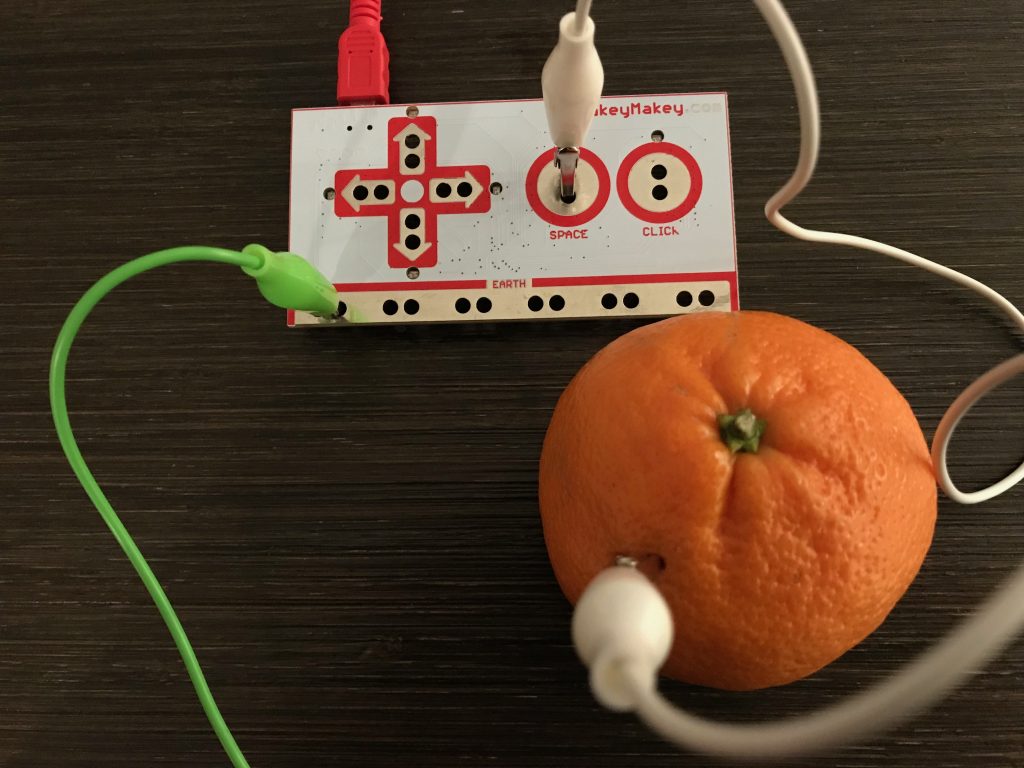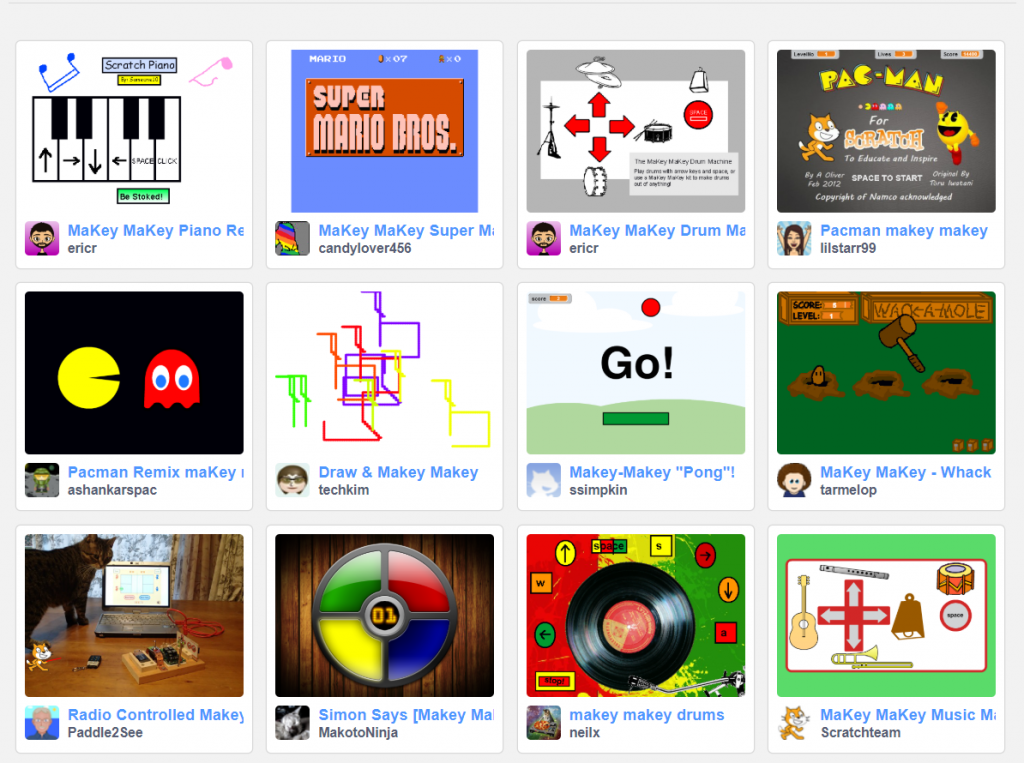For the Community Engagement project in this quarter’s Teaching, Learning and Assessment 1 class, I chose to create a lesson that tied a hands-on technology lesson to 4th grade students’ learning about electrical circuits.
Background
I am fortunate to work with a talented technology teacher who introduced me to Makey Makey, a simple circuit board that connects to a PC via a USB cable and can be used, among other things, to show students in a visceral way how different materials either conduct or insulate electrical current, and the difference between an open and closed circuit.

After working with the tech teacher in her classes, I taught a similar lesson in a 4th grade class at another school. I opened with a brief description of conductive and insulative materials and the way that electricity requires a closed circuit to flow. I asked students if they remembered learning about this in their unit on energy, and a few students raised their hands but the rest appeared to not remember. Though the class was very engaged during the hands-on part of Makey Makey, I couldn’t help thinking how much more meaningful the lesson could have been if it had done within the context of the Magnetism and Electricity module of their Science curriculum.
A simple version of this lesson can be done using any app (such as Word) that uses the arrow keys, space bar or mouse since Makey Makey maps these inputs (key-presses, mouse clicks) to places on the Makey Makey board that you can connect different objects to. However to make it more interesting and to integrate coding concepts into the lesson, students can write their own simple program in Scratch (see Introduction to Makey Makey video below).
Thinking About Thinking
The DEL program, and this class in particular, is making me think about thinking, or metacognition, in the context of teaching technology. Because technology classes in the schools I work in are not graded and time with students is limited to once per week, there is no formal assessment done to determine how much students have learned. This will undoubtedly change as computer science classes become mandatory in K-8, but until then each tech teacher has to do their own form of assessing student knowledge.
I used this community engagement assignment to consider, in a perfect world where computer science/physical computing class is part of daily or almost daily learning, what could be done to help students think about what they have learned in the context of the lesson. Though the flashy aspect of the project is memorable (touching a banana made the cat jump!) how can students make a strong connection to other parts of their learning?
Understanding by Design
Understanding by Design, also referred to as UbD (Wiggins & McTighe, 2005), invites educators to take a backwards approach to lesson design: start with what understandings you want your students to walk away with after doing the lesson and design the lesson accordingly.
Following the UbD process, I broke the lesson design into three stages:
Stage 1: Desired Results
To establish goals and understandings as outlined by UbD, I reviewed the Next Generation Science Standards (NGSS) and Washington State K-12 Computer Science standards for 4th grade to determine which could be supported in the lesson, as well as what basic understandings in electricity and computer science appropriate to this grade level could be gained and which essential questions should be covered.
Stage 2: Assessment Evidence
Starting with how I might assess evidence of student learning, as well as how students might assess their own learning, completely drove the lesson plan (which I realize was the whole point of the exercise). I started by trying to determine what the class might already know about electricity and circuits using a class mind mapping exercise (Gates).
Following the completed project, I chose to have student pairs share what they had learned in front of the whole class and complete an Engineering Notebook (document embedded at the end of the post) that encouraged them to think about what they learned regarding circuits, conductivity; input/output, events, and comments in Scratch; and finally, how they worked together as a team.
At the suggestion of my instructor, I created a basic rubric to make it clear to students what criteria they were being assessed on. The rubric also includes a column for students to assess their own work.
Stage 3: Learning Plan
My learning plan broke down the project into three segments:
- An introduction to determine what students already knew about electrical circuits, filling in the gaps through discussion and a short video; an explanation and demonstration (or video) of Makey Makey, and a demonstration of how to build a basic program in Scratch.
- Hands-on coding in Scratch, testing materials, building the input devices, and responding to the prompts in the Engineering Notebook.
- Each pair of students presenting their findings and project to the class as outlined in the Engineering Notebook, followed by an all-class discussion of understandings and essential questions.
The complete Lesson Plan and the Engineering Notebook are embedded at the end of this post.
The Six Facets of Understanding
The UbD process breaks down the term “understanding” into six components: Explanation, Interpretation, Application, Perspective, Empathy, and Self Knowledge (Wiggins & McTighe 2005). In my lesson, I tried to address each as follows.
- Students can explain what facts they have acquired and their interpretations of the topic through their class demonstrations and Engineering Notebook entries.
- Students apply what they learned by coding a program, making an input device that conducts electricity, and successfully building a working electric circuit.
- Perspective can be gained for those students who might not see themselves as having anything in common with programmers or scientists, but suddenly, here they are, coding and experimenting. They might also gain perspective on problems faced during the project while working with a partner who may offer different solutions or ways of looking at the problem, or when watching their classmates’ project demonstrations.
- Empathy could be experienced through difficulties they face in the project (“this must be what programmers or electrical engineers deal with all the time”), in trying to help their partner understand something, or in relating to any struggles with the project that their classmates describe.
- Self Knowledge comes into play through participating in the mind mapping exercise, completing the Engineering Notebook (including the page on how well students worked together as a team), and the self assessment part of the rubric.
Digital Citizenship
As part of this assignment, we were to consider how the ISTE Student Standard 2, Digital Citizen, could be factored into our lesson. Most of this lesson, with the exception of using Scratch and watching an online video, is offline. An online component could be added to it, however, by going to the main Scratch website as a class and looking at other posted Makey Makey projects. The teacher could demonstrate how Scratch projects can be “remixed” and how credit can be given to the original creator on the opening page of a project. The teacher could also model leaving a comment on a particularly compelling project that the class voted on.

Project Reflection
This project, though challenging given my lack of formal teacher training, was an excellent learning experience. I really appreciated the UbD process and found it immensely helpful to start with the essential understandings I wanted students to gain from the lesson and work backwards from there.
Areas I think need work include the amount of time the lesson takes in its current form. I know that it is unrealistic given how technology classes are currently being taught in K-5. Also, I wonder in my drive to assess knowledge if I am taking some of the fun out of the lesson by requiring them to fill out the Engineering Notebook. I know some students will not enjoy the process. I would try to pair a student who likes to write with one who might prefer explaining things verbally so the work could be shared in a way that allows them to apply their strengths.
If I was working with a class that was experienced in Scratch, I would like to open the project up and allow students to create any program in Scratch that used the minimum 5-6 main Makey Makey inputs, plus more if they were so inclined (Makey Makey has additional, harder to connect to ports on the back of the board). I also would like to encourage students to bring materials from home that they want to test and really get creative with the input device design.
Lesson Plan
 Loading...
Loading...
Engineering Notebook
 Loading...
Loading...
References
DK Findout Energy. (2018). Stanford, O. Dutta, A., Gupta, K., (Eds.). New York, NY: DK Publishing.
Gates, J. 4th Grade Science unit 9, lesson 1, pre-assessment. BetterLessons.com Retrieved from: https://betterlesson.com/lesson/638983/pre-assessment
Introduction to Makey Makey (2015). Teaching Robots. Retrieved from:
http://bit.ly/2CorEB0
Next Generation Science Standards – 4th Grade (2013). Retrieved from: https://www.nextgenscience.org/sites/default/files/4%20combined%20DCI%20standardsf.pdf
Next Generation Science Standards – 4th Grade-topical model-bundle 2 energy transfer and information transmission (2016). Retrieved from: https://www.nextgenscience.org/sites/default/files/4th%20Topical%20Model%20Summay%20and%20Flowchart.pdf
Next Generation Science Standards – 4th Grade summary and flow chart (2016). Retrieved from: https://www.nextgenscience.org/sites/default/files/4th%20Topical%20Model%20Summary%20and%20Flowchart.pdf
Washington State Learning Standards Kindergarten – 12 Computer Science (2018). Retrieved from: http://www.k12.wa.us/ComputerScience/pubdocs/CS-Standards.pdf
Wiggins, G. & McTighe, J. (2005) Understanding by Design. Upper Saddle River, NJ: Pearson